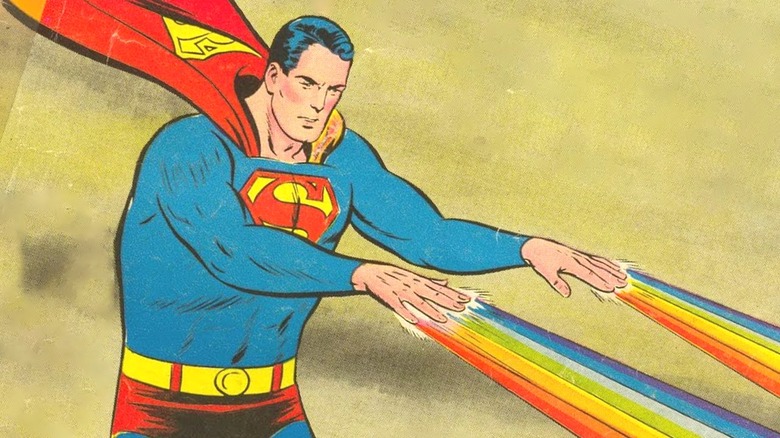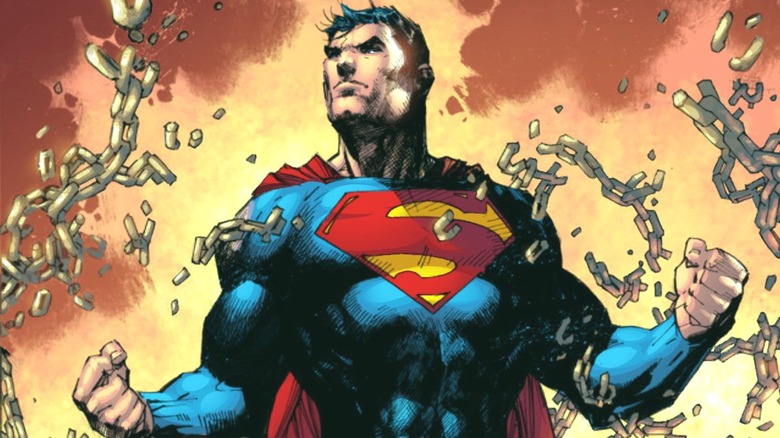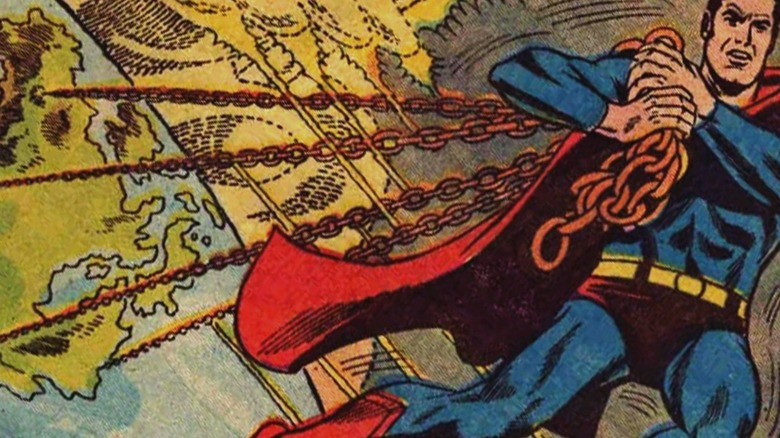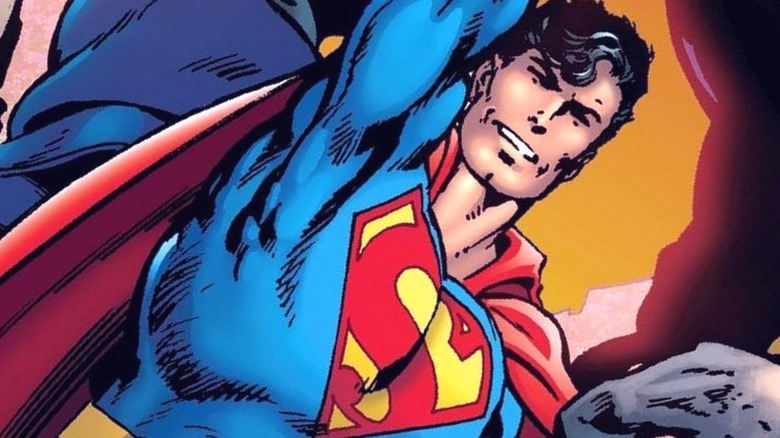How Strong Is Superman? His Powers Explained
Superman is the OG comic book superhero, having first appeared in "Action Comics" #1 in 1938, and he's remained in print ever since. Because Superman has been around for nearly a century, hundreds of artists and writers have helped shape and reshape the character. As a result, modern depictions of Superman are quite different from the Golden Age hero who could "leap tall buildings in a single bound."
In terms of strength, that's a power that has seen some serious fluctuations throughout Superman's history. In the beginning, he could hold up a car or bend a steel rod. As he progressed, Superman was seen holding up islands, towing the continents, and even hauling entire solar systems. The origins of Superman's powers have also changed, and while he's well-known to derive his abilities from the radiation of Earth's sun, that wasn't initially the case. Regardless, in every depiction, Superman is shown to be one of the strongest and most powerful beings in existence. But just how strong is he?
That's a question that has plagued comic book fans for years. It's been difficult to answer because depictions of his strength in the comics, movies, cartoons, and video games have varied. Fortunately, DC Comics recently clarified the actual levels of strength Superman potentially has, so after more than 85 years in publication, it's possible to quantify just how strong the so-called Last Son of Krypton is. As you likely suspect, it's immense.
Superman's powers have always been a little wonky
There have been many versions of Superman, but even focusing on the main continuity's Man of Steel, there have been plenty of superpowers that people didn't know he had. Initially, he could shapeshift, he had something called super ventriloquism, and in Superman #125, he gained the ability to shoot miniature versions of himself from his fingertips (pictured). These days, he's far more regulated and has less overtly unusual powers.
Superman has also been transformed into a solar god, and he's split into two separate versions of himself. While these superpowers are weird and don't make a lot of sense, it's understandable given how long Superman has been in print. If his powers never evolved in any way, he'd become stale, and you can see the same occurring with comic book characters in other universes as well. The X-Men tend to mutate every so often, gaining new abilities or transforming in some way.
Every once in a while, the standard-issue Superman gains something new, which has happened relatively recently. In 2011's "Superman" #38, the Man of Steel is pushed to his absolute limit in a fight against Ulysses. Supes uses his heat vision beyond normal levels, engaging a new super flare power for the first time. This is his most devastating ability, unleashing all of his stored solar energy at once, but at a cost. When he uses it, Superman is depowered completely for 24 hours so his cells can recharge.
Superman isn't called The Man of Steel for no reason
When he first appeared, Superman was no slouch in the strength department, quickly earning the moniker of the Man of Steel in recognition of his durability and penchant for breaking steel chains. Originally, Superman derived his superpowers from Earth's comparatively low gravity. It was said that Kryptonians were at peak physical shape, and the harsher gravity of Krypton ensured that its people would be able to achieve great feats on Earth.
This is why he couldn't fly in the beginning, so instead he bounded about the planet with ease like astronauts on the Moon. Superman also had few weaknesses when he first appeared, as Kryptonite was invented so that Bud Collyer, the actor who played Superman in the 1943 "Adventures of Superman" radio show, could take a weeklong vacation. It was six years before anyone over at DC Comics bothered to introduce the little green rocks into printed stories, so in the beginning, there wasn't much that could stop Superman.
Of course, he didn't fight supervillains in the early days and was more interested in going up against evil land barons and the like. Over time, Superman's powers progressed, and many elements that were introduced in the radio show, including his ability to fly, found their way into the comics. Eventually, Superman became so powerful that he needed to be reigned in, as he was all but undefeatable by even the most powerful villains in his expansive rogues gallery.
Pre-Crisis Superman got a little too powerful
As time passed and new, more powerful threats came his way, Superman became increasingly stronger. This wasn't only true of the adult Superman, because Superboy was also shown to be ridiculously overpowered at times, especially during the Silver Age of Comics. In 1967's "Superboy" #140, he casually drags an entire solar system of 13 planets using giant chains without breaking a sweat. That's a level of power that essentially made the Boy of Steel a god, but it's hardly the only example of extreme super strength.
For Superman, one of his strongest feats came in "Superman" #220, published two years later, when he was forced to move the Earth. He does so, exclaiming, "Stand back, Flash ... I must exert more force than a million H-bombs!" He then slams into the ground, pushing Earth out of the way of a so-called "planet-rending force." In "World's Finest" #208, Superman uses mystical chains to separate Earth-2's continents (pictured) while working with Doctor Fate.
Other examples of Superman's powers being excessive during the Silver Age include a moment in "Action Comics" #273, where he accidentally sneezes and destroys an entire solar system. Clearly, when a comic book character is that strong, there's not much that can be done with him — how is a reader to relate? This was one of the reasons it was decided that Superman and the DC Universe needed some tweaking, resulting in 1985's "Crisis on Infinite Earths."
Post-Crisis Superman kept the Last Son of Krypton more grounded
Marv Wolfman and George Pérez's "Crisis on Infinite Earths" event changed comic books forever, while also upending the DC Universe. There were many reasons for the Crisis, including Superman's power levels, and he was somewhat nerfed in its aftermath. The first story published after the event to feature the new and improved Superman was John Byrne's six-issue miniseries, "The Man of Steel." The series is considered one of the greatest Superman stories ever told, and it established many aspects of his lore that remain in place today.
The books replaced Superman's origin story, which DC Comics reset in a later shakeup. Still, Byrne's Superman was the one many who grew up reading the comics in the 1980s, '90s, and early 2000s know best. Post-Crisis Superman isn't as strong as his Silver Age counterpart, but it's not as if he's a weakling either. Instead, he was grounded somewhat into a more relatable hero who could be harmed, which made him a more dynamic and interesting character.
The stories spawned from the reboot often brought great peril Superman's way, including "The Death of Superman." In the years since, Superman's powers have increased significantly, including the narrative in Grant Morrison and Frank Quitely's "All-Star Superman." In that series, Superman's cells are saturated with solar radiation. When his strength is tested, he holds up a weight of 200 quintillion tons with one hand behind his back, but this was outside the normal continuity.
DC finally confirmed Superman's upper limit... sort of
One of the most challenging things for a fan to do is quantify Superman's strength, but DC Comics made it possible via "Nightwing 2022 Annual" #1. In the comic, Nightwing begins to train the new Superman, Jonathan Kent. Despite being younger, Jon is stronger than his father, and the story offers some data that makes it possible to determine his potential strength using math. When Nightwing asks him to hit a dummy at quarter strength, he punches it out of view, noting it will "burn up on reentry."
Assuming that the dummy weighs approximately 122.47 kg (270 lbs.), and it flew into a decaying Low Earth Orbit (LEO), it's possible to calculate the total energy required. It takes 3.31 x 10⁷ joules (33,100,000, or 33.1 megajoules) to reach escape velocity and place one kg (2.2 lbs.) into LEO. Multiplying that by the weight of the dummy, Jon's quarter-strength would amount to approximately 4,053,757,000 joules, or 4.053+ gigajoules. That means Superman's full strength is over 16.215 billion joules of energy.
For reference, a joule is the amount of force equivalent to one newton required to move an object one meter (3.28 feet). It's essentially the amount of energy needed to lift something the size of an apple one meter. These calculations are rough and conservative, and while DC's Superboy is impossibly strong, it seems he's ridiculously overpowered in the story. For comparison, a normal person's punch might go as high as 150 joules.





